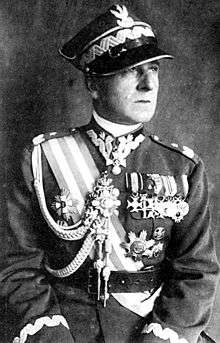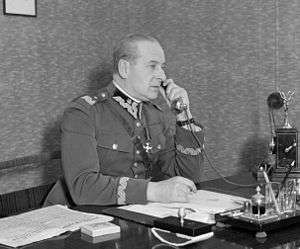Bolesław Wieniawa-Długoszowski
| General Bolesław Wieniawa-Długoszowski | |
|---|---|
 | |
| President of the Republic of Poland | |
|
In office 25 September 1939 – 26 September 1939 | |
| Preceded by | Ignacy Mościcki |
| Succeeded by | Władysław Raczkiewicz |
| Personal details | |
| Born |
22 July 1881 Maksymówka |
| Died |
1 July 1942 (aged 61) New York City, New York |
| Nationality | Polish |
| Spouse(s) | Stephania Calvas, Bronisława Wieniawa-Długoszowska |
Bolesław Ignacy Florian Wieniawa-Długoszowski (22 July 1881 – 1 July 1942) was a Polish general, military adjutant of Chief of State Józef Piłsudski, politician, diplomat, poet and an artist, as well as formally President of the Republic of Poland for one day.
Before World War I

Bolesław Wieniawa-Długoszowski was born on 22 July 1881, in his family's estates in Maksymówka (near Stanisławów – now Ivano-Frankivsk). He was a son of a Polish nobleman Bolesław Długoszowski and Józefina Struszkiewicz.
In 1877 his family had moved to a palace on another family estate, in Bobowa. There Bolesław spent his early life. He attended a gymnasium in Lwów, where he was one of the best students. Subsequently he moved to a school in Nowy Sącz. There, in 1900, he passed his graduation exams. Afterward he studied medicine at Jan Kazimierz University in Lwów, gaining a special diploma with high distinction.
After his studies he moved to Berlin where he spent a year studying at the Berlin Academy of Arts. After finishing his degree there he moved to Paris, where he worked as a private doctor. In 1911 he was one of the founders of The Union of Polish Artists (Towarzystwo Artystów Polskich). He also joined the Riflemen's Association (Związek Strzelecki "Strzelec"). There he met Józef Piłsudski.
1914–1942
In 1914 he moved to Kraków and joined the First Cadre Company which fought on the Austro-Hungarian side against Russia. In October 1914 he became a commander of a platoon of a squadron in 1 Pułk Ułanów Legionów Polskich. During the fighting in 1914–1915 he was promoted to lieutenant, and after the war he was awarded the V-Class Virtuti Militari. In August 1915 he moved to the special group in Warsaw. Soon he became an aide-de-camp to Józef Piłsudski. In 1918, while on a mission to Russia, he was arrested by the Soviet Cheka as a member of the Polish Military Organisation. He was freed after several months.
As aide-de-camp of Józef Piłsudski during the Polish-Soviet War he helped him organize the Vilna Operation and Battle of Warsaw. He was also a commander of 1st Cavalry Division. After the war, Wieniawa was awarded many medals (including the Légion d'honneur, Cross of Valor and Cross of Independence).
In November 1921 he became the Polish military attaché in Bucharest, Romania. He was associated with making the Polish-Romanian convention which was signed in 1922.
In 1926 he passed his exams in High War School, and soon became a commander of 1 Pułk Szwoleżerów Józefa Piłsudskiego – the most prestigious and representative Polish cavalry division. He commanded it until 1930.
During the May Coup he was one of Piłsudski's officers. He helped him to organize the coup.
In 1930–32 he was commander of I Cavalry Division and, for some time, of II Cavalry Division. In 1931 he was promoted by President Ignacy Mościcki to the rank of Brigadier General. In 1932 he became commander of II Cavalry Division and performed his duties until 14 May 1938. In 1938 he was promoted to Major-General. From 1938 to 13 June 1940, he was the Polish Ambassador in Rome.
One-day Presidency
On 17 September 1939, he was nominated president of Poland by retiring President Ignacy Mościcki. On the same day, Poland was invaded by the Soviet Union and he emigrated to Paris to perform his new role but was blackballed by Władysław Sikorski, the French Third Republic and the United Kingdom. After the capitulation of France he emigrated to Lisbon but soon he moved to New York.
Many sources do not list Wieniawa as President, merely "designated successor". However, according to the then constitution, when the President can not execute his powers (as when Mościcki was interned in Romania and it was clear that he would not be released unless he resigned), the designated successor automatically became President.
After receiving appointment or becoming President, Wieniawa asked Cardinal August Hlond to become Prime Minister. Hlond refused, referring, noteworthy fact, to Wieniawa as, "Mr. President".
Also in a press statement from President Lech Wałęsa's press secretary on 21 September 1994, to Dziennik Polski Wieniawa-Dłogoszowski was referred to as one of the legitimate Presidents in Exile.[1]
According to some opinions Mościcki intended to pass his office to Wieniawa-Dłogoszowski as a caretaker, until a candidate accepted by both Sanacja and opposition circles, General Kazimierz Sosnkowski, whose whereabout was unknown in September 1939. Finally compromise candidate Władysław Raczkiewicz was chosen after Wieniawa resignation.[2]
Death
Wieniawa became Polish Ambassador in Havana, but after moving to Washington he died by his own hand.[3] Some sources[4] state that he committed suicide by leaping from an upper story of a New York city residence, but the exact details of his death are debated among historians.
Honours and awards
Polish
- Order of the White Eagle
- Order of St. Stanislaus
- Knight's Cross of the Virtuti Militari
- Cross of Valour, four times
- Cross of Independence with Swords (May 1931)
- Commander's Cross of the Order of Polonia Restituta (previously awarded the Officer's Cross)
- Gold Cross of Merit
- Decades of Independence Medal Regained
- Gold "Academic Laurel" for his contribution for the good of the literature (1936) [14].
In 1936, he was awarded the Golden Laurel of the Polish Academy of Literature Academic merit for literature.
Foreign
- Imperial Order of Leopold (Austria)
- Military Order of Max Joseph (Bavaria)
- Commander of the Legion of Honour (France)
- Military Order of Maria Theresa (Austro-Hungarian Empire)
- Order of Saints Cyril and Methodius (Bulgaria)
- Croix de guerre 1914–1918 (France)
- Knight of the Equestrian Order of the Holy Sepulchre of Jerusalem (Holy See)
- Grand Officer of the Order of Saints Maurice and Lazarus (Italy)
- Commander of the Order of the Star of Romania
- Commander of the Military Merit Cross (Austria-Hungary)
- Commander of the Order of the White Eagle (Yugoslavia)
- Commander of the Order of the Three Stars (Latvia)
- Grand Commander of the Order of Merit (Hungary)
- 10th Anniversary Commemorative Medal Fight for Liberation of the Republic of Latvia
| Political offices | ||
|---|---|---|
| Preceded by Ignacy Mościcki |
President of the Polish Republic 1939 |
Succeeded by Władysław Raczkiewicz |
References
- ↑ Heydel-Mankoo, Rafal. THE POLISH ARISTOCRACY: THE TITLED FAMILIES OF POLAND.
- ↑ Olgierd Terlecki, Generał Sikorski. Wydawnictwo Literackie, Kraków 1983
- ↑ Lerski, George J.; Lerski, Jerzy Jan; Wróbel, Piotr; Kozicki, Richard J. (1996). "Wieniawa-Dłogoszowski, Bolesław". Historical dictionary of Poland, 966–1945. Greenwood Publishing Group. p. 650. ISBN 978-0-313-26007-0. Retrieved 8 July 2009.
- ↑ Pinkowski Files. Poles.org.
Bibliography
| Wikimedia Commons has media related to Bolesław Wieniawa-Długoszowski. |
- Szuflada Generała Wieniawa, edited by Elżbieta Grabska and Marek Pitasz, Państwowy Instytut Wydawniczy, Warsaw 1998
- Ulubieniec Cezara – Wydawnictwo MSW, Warszawa 1990
- Belonging and Betrayal, The life of Bronisława Wieniawa Długoszowska, Gervase Vernon, Amazon 2013
